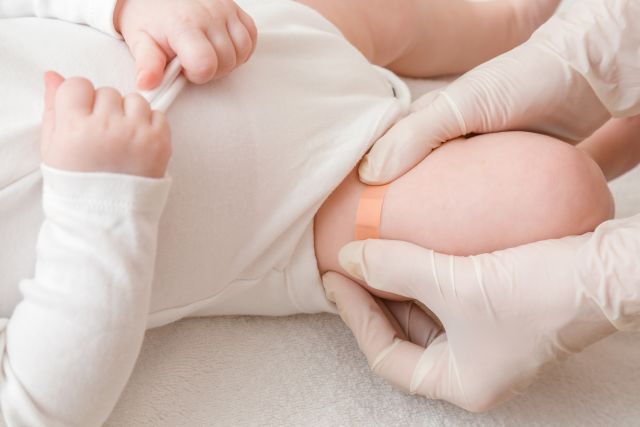Updated on September 12, 2022.
In the early 1950s, polio was feared. Parents wouldn’t let their kids go outside, pools and theaters were closed, commuting between cities was often restricted, and quarantines were part of life. Since the first U.S. polio vaccine was introduced in 1955, cases fell from tens of thousands each year to fewer than 10 in the 1970s. In fact, there hasn’t been a confirmed local polio transmission in the United States since 1979. Until recently.
In 2022, an unvaccinated adult from Rockland Country, New York with no history of international travel caught the disabling virus and become paralyzed due to the infection.
Why is this happening now?
Widespread vaccination over the past several decades effectively eliminated polio from the U.S. The disease no longer circulates year-round, but it takes only one case to bring it back, health officials warn. High levels of immunity among the population through routine childhood immunizations are the best defense against polio.
Herd immunity is achieved once enough people survive infection and/or get vaccinated, making the spread of the disease unlikely (at least for a certain period of time, depending on how long immunity lasts). For example, 95 percent of a population needs to be vaccinated against measles to prevent its spread. For polio, about 80 percent of the population must be immune.
Adults in the United States who were fully vaccinated during childhood are likely to remain protected from polio. Pockets of unvaccinated people in certain parts of the country, however, have left the door open for polio to return. In Rockland County, NY where the latest polio case was detected, polio vaccination coverage is only 60 percent. In at least one part of the county, rates may be as low as 37.3 percent. By comparison, across the U.S., polio vaccination rates during the first two years of life are upwards of 92 percent, according to the CDC.
“Low vaccination coverage in the patient’s county of residence indicates that the community is at risk for additional cases of paralytic polio,” according to a study from the Centers for Disease Control and Prevention (CDC) published in August 2022. “Even a single case of paralytic polio represents a public health emergency in the United States," the researchers wrote.
The inactivated polio vaccine (IPV) is currently part of the routine series of vaccinations that kids get, starting at the age of 2 months. Three additional doses are given at 4 months, between 6 and 18 months and between 4 and 6 years of age. Kids who get all four IPV doses as recommended, are 99 percent protected from the disease, the CDC reports.
The strain of polio involved in the New York case that occured in June, however, is linked to an oral vaccine that hasn’t been used in the United States for more than two decades, according to the CDC's August 16 study. This oral vaccine uses a live but weakened virus strain. As a result, unvaccinated people can get the virus from people who were recently immunized, the CDC explained. The polio vaccine currently used in the United States contains an inactivated virus that can’t spread from person to person. But the oral vaccine is still used in some other countries.
Since the June case was confirmed, wastewater samples collected in the New York metro area suggest the virus may have been circulating in the state for months. The samples, which were collected as part of the COVID monitoring system, identified 21 samples that were positive for polio, the CDC revealed. Health officials also found the New York samples and the June case were genetically linked to wastewater samples collected in Israel and the United Kingdom.
How do you get polio—and what happens?
Polio is caused by the poliovirus. It spreads easily through person-to-person contact. It lives in the throat and intestines of infected people. So, people can get it through:
- Contact with contaminated feces, or poop
- Exposure to respiratory droplets from infected people, such as sneezes and coughs
For example, unvaccinated people can become infected by eating or touching their mouth with unclean hands after using or cleaning the bathroom, changing a diaper, or touching a contaminated surface. Putting contaminated objects into your mouth or consuming contaminated food or water can also spread the virus.
Those who are infected are contagious right before their symptoms appear and they could continue spread the virus for up to two weeks afterward. Those who never develop symptoms can still infect others. The virus can live in someone’s intestines for weeks and contaminate food and water in unclean conditions.
Poliovirus may not cause any symptoms. About 25 percent of people with polio develop flu-like symptoms, such as sore throat, fever, fatigue, nausea, and headache. These symptoms often resolve on their own in a few days.
A smaller proportion of people with polio develop more serious issues. Some may experience weakness in the arms and/or legs or paresthesia (feeling of pins and needles in the legs). For up to 5 percent of people, the virus infects the brain and spinal cord, resulting in meningitis (infection of the spinal cord covering). And as many as one in 200 people may experience paralysis, or the inability to move certain parts of the body. In severe cases, polio can be deadly when the virus debilitates the muscles people use to breathe.
Those who’ve had polio when they were younger may be affected again later in life. They can develop post-polio syndrome, or new muscle pain, weakness, or paralysis, decades after their recovery.
There is no cure or specific treatment for polio paralysis, but physical or occupational therapy may help improve muscle weakness over time.
Are you protected?
All children should receive four doses of the IPV vaccine as part of their routine childhood vaccine series by the time they are 6 years old.
Kids who have not started their polio vaccine series or are delayed in getting one or more doses, should start their immunizations as soon as possible, or complete the series on a catch-up-scheduled as recommended by their healthcare provider (HCP). It’s particularly important to be vaccinated against polio before traveling outside the United States, the CDC cautions.
Adults who are unsure if they or their children have been immunized, can check for records in a few places:
- Family members who may have kept documents
- The medical office or clinic where the vaccines may have been given
- Schools they attended or student health centers
- Their local or state health department
People who have never been vaccinated or have no records of their vaccinations should receive three doses of IPV. The first shot should be received as soon as possible. The second dose can be received 1 to 2 months later, and the third shot can be received 6 to 12 months after the second dose.
Those who have only partially completed their polio vaccine series should get the remaining doses.
Adults who were fully vaccinated against polio earlier in life but have a high risk of exposure to the virus due to travel, their job, or other circumstances can get one lifetime booster dose of IPV. Talk to your HCP about what is safe and appropriate for you.
"Polio immunization is safe and effective—protecting nearly all people against disease who receive the recommended doses," Dr. Bassett said. "Do not wait to vaccinate."






